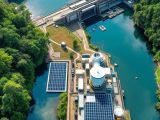
BASF ECMS Launches Budenheim PEM and Fuel Cell Plant
November 7, 2025Think Europe’s hydrogen moment has already come and gone? Head over to Budenheim, just outside Frankfurt, and you’ll see something different. In July 2024, BASF ECMS broke ground on a shiny new production hub due to fire up by summer 2025. Instead of churning out hydrogen itself, this plant will turn out the critical pieces that make green hydrogen generation and fuel-cell power actually work.
Why Budenheim?
Budenheim isn’t just another dot on the map. Nestled in the Rhein-Main industrial corridor, it’s got decades of chemical-industry know-how under its belt, top-notch infrastructure and a talent pool ready to roll. Plus, Frankfurt’s a stone’s throw away—hello, easy access to ports, freight trains and highways. All that makes Budenheim the perfect pit stop for shipping delicate membrane and electrode assemblies across Europe’s growing market for PEM electrolyzers and other fuel cell components.
Breaking Down the Tech
Here’s the real scoop: this plant focuses on two headline-grabbers:
- Low-iridium Catalyst Coated Membranes (CCMs): These proton exchange membranes sit at the heart of PEM electrolyzers. By cutting back on pricey iridium, BASF ECMS is tackling both cost and supply risks—making green hydrogen more wallet-friendly and scalable.
- Celtec® Membrane Electrode Assemblies (MEAs): Designed for high-temperature fuel cells, these assemblies convert hydrogen into electricity with standout efficiency. They thrive in tougher conditions where lower-temp designs often stumble.
“We’re thrilled to be on the forefront of designing materials that slash precious-metal use while ramping up performance,” says a BASF ECMS spokesperson. “This facility is a game-changer for lowering the total cost of ownership on electrolyzers and all kinds of fuel cell components worldwide.”
Behind the Scenes
This isn’t a solo act. Alongside BASF ECMS, two German partners bring their A-game:
- Trigona Fuel Cell Components GmbH handles the nitty-gritty of manufacturing those Celtec® MEAs, making sure every piece meets sky-high quality standards.
- Grundstücksverwaltung Rheinufer GmbH & Co KG provides the real estate, utility hookups and logistical muscle on the Budenheim site.
Together, they’ve built a supply chain that’s fast, flexible and seriously green.
What’s at Stake?
Why does it matter? Here’s the rundown:
- Decarbonization: By powering up cost-effective PEM electrolyzers and high-temp fuel cells, the plant backs the EU’s climate goals and helps industry ditch fossil fuels.
- Circular Economy: BASF ECMS is ramping up precious-metal recycling for catalysts, shrinking lifecycle impacts and resource risks.
- Economic Boost: While the final tally isn’t public, expect skilled jobs, local training programs and a stronger European foothold in the global hydrogen economy.
- Energy Sovereignty: Making these critical components at home cuts reliance on imports and beefs up resilience across Europe’s energy network.
“With this investment, we’re not just erecting walls and machinery; we’re building a backbone for a truly sustainable hydrogen ecosystem,” adds the BASF ECMS team.
Looking Ahead
When summer 2025 rolls around and the first batches of low-iridium catalyst coated membranes and Celtec® MEAs hit the line, the Budenheim plant will be ready to ramp up fast. And it’s built with expansion in mind—just in case green hydrogen demand surges even harder.
For businesses and communities, that means cleaner power in remote spots, rock-solid backup for data centers and greener industrial processes. Every electrolyzer and fuel cell using these parts will carry a bit of Budenheim’s innovation. Because at the end of the day, the hydrogen revolution isn’t just about big announcements—it’s about the membranes, catalysts and assemblies that bring the vision to life.


 With over 15 years of reporting hydrogen news, we are your premier source for the latest updates and insights in hydrogen and renewable energy.
With over 15 years of reporting hydrogen news, we are your premier source for the latest updates and insights in hydrogen and renewable energy.